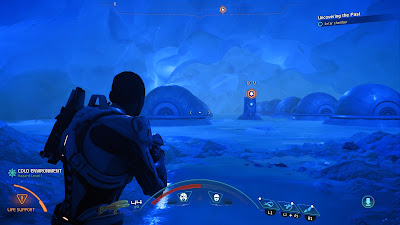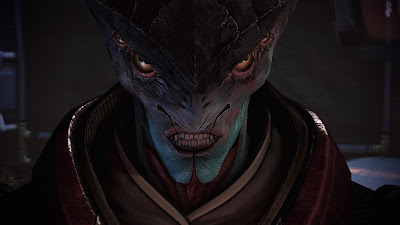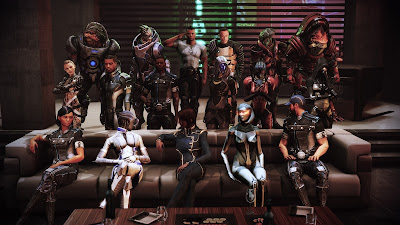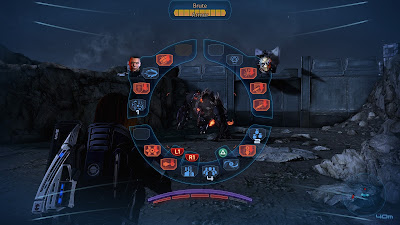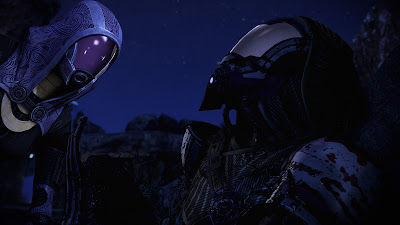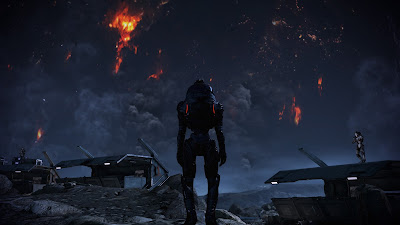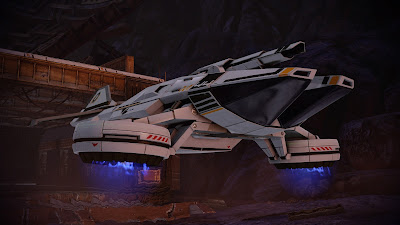Note: Anthem's servers go off-line on January 12, 2026. The game will be unplayable after that date. This review will stay up for archive purposes.
THE PLOT:
Bastion is a dangerous land, rocked by frequent Catacylsms - unpredictable forces of nature that can rip apart reality itself. Silencing these events used to be the job of Freelancers, famed warriors clad in exosuits known as Javelins. Until the day the Dominion attacked the prosperous city of Freemark, setting off an enormous cataclysm known as The Heart of Rage. Freelancers fought, both to protect the city and to silence the cataclysm... only to fail completely.
Ten years later, one of the few survivors of the Heart of Rage is working out of the small outpost of Fort Tarsis, taking any odd jobs that come up for the now-disgraced Order with help from a Cypher named Owen. When they stumble across renewed Dominion activity, they learn that a man known only as "The Monitor" is making plans to enter The Heart of Rage - determined to bend creation itself to his will!
 |
| The game's greatest joy: Flying around Bastion in your Javelin. |
CHARACTERS:
Anthem actually does fairly well with its major characters. Dialogue options allow you to be sarcastic or sincere, brusque or compassionate, but the character remains essentially likable regardless. The support team - Haluk a grizzled ex-freelancer who now largely acts as a mechanic, and Owen and Faye, two different Cyphers who are haunted by their pasts in their own ways - are generally well-characterized, with just enough bickering and jealousy to believe them as different people with differing priorities but not so much as to alienate them from the player. It's a Bioware game, so it should come as no surprise that voice acting ranges from good to excellent.
Other NPC's vary. I quite liked two of the main quest givers: Sentinel Brin, who is socially awkward and abrasive, but who gradually develops into a friend; and Arcanist Matthias, whose story takes an unexpected direction after a close encounter with a Shaper relic. Other NPC's are less engaging. The game expects me to find charming the character of Ryth, an irresponsible fellow Freelancer who inserts the word "sexy" in front of virtually every noun ("sexy danger"); I quickly found myself wishing for a dialogue option that would leave her to deal with the consequences of her "sexy bad choices" without me. And the less said about a distraught mother who mistakes you for her long-dead child, the better.
 |
| Chatting with the bartender at Fort Tarsis. |
GAMEPLAY:
One of the bizarre things about Anthem's failure is that the gameplay... is actually pretty darn good. I've seen it dubbed "the best Iron Man game ever made" for its fun, intuitive flight controls. Combat is rapid, encouraging the player to mix it up with various weapons, grenades, close-quarters melee, and burst attacks that can range from explosions to poison sprays. Just flying from one objective to the next can be a joy, only briefly interrupted by the flight system's cooldown.
Unfortunately, the game struggles to create objectives that fully utilize the flying and combat systems. Too many missions consist of fighting swarms of enemies while picking up Object A to deliver to Drop Site B. Or defending an area from enemies while your Cypher... um, does something. Followed by clearing the area of enemies before going onto the next location.
A few missions offer enough variety to at least hint at the gameplay's potential. One quest cuts you off from your support, leaving you to battle giant Titans on your own. The final boss battle is an enjoyably challenging three-stage combat in which each stage requires an entirely different type of play. Other missions take away your flight abilities due to enemy interference. But these change-ups are few and rare, with most quests ultimately falling into very familiar and repetitive categories.
 |
| The battle with The Monitor - the game's best fight. |
THOUGHTS:
Anthem is a notorious failure. Indeed, my decision to kick off my Bioware reviews with it is entirely because of EA's unsurprising decision to halt future development on it. Sure, they're keeping the servers up for the foreseeable future - but smart money's on the game disappearing entirely in the next 2 - 3 years (Updated to Note: The servers will sunset in January 2026, and Anthem will then be a dead game. Which is unsurprising, but I'm still a bit sad about it).
I should emphasize that I never endured the Anthem launch day experience, when the game was apparently riddled with bugs and crashes and boasted loading screens that lasted longer than the actual missions. I learned long ago that gaming is the one major entertainment medium that actually punishes consumers for buying its products new. Buy new, and you pay too much for something broken; wait, and you pay much less for something that works much better (see also: No Man's Sky; Assassin's Creed: Unity; Mass Effect: Andromeda; and more recently, Cyberpunk 2077) - an issue that's worthy of discussion in itself.
In any event, I am only reviewing Anthem as it exists now. I did not pay $80 for a broken game; I paid $10 for a game that works just fine. The problems that remain - and there are many - are largely ones of misjudgment rather than incompetence.
ANTHEM VS. DESTINY
It's clear enough that Anthem was made to compete with Destiny. And I'll say it: With a full three-act story and about 40 hours of content, Anthem's core game is far more complete than Destiny's was when it launched in 2014.
There's just one problem... Anthem wasn't competing with the 2014 version of Destiny. By the end of 2015, Destiny started making its stories and characters as enjoyable as its gameplay, with its excellent Taken King expansion effectively transforming the game. By the end of 2017, Destiny 2 had launched with a story-intensive campaign that offered a frankly much stronger narrative than Anthem's.
Finally, even at launch, Destiny provided players with a unique and detailed universe, and a variety of different worlds and setting. Anthem's game world is gorgeous... but it's also quite small, and comparatively generic.
 |
| A mission in a mine. Most underground settings look pretty much like this. |
MISJUDGMENTS AND MISSED OPPORTUNITIES
Anthem wants to tell an exciting action tale, much as Bioware's single-player games have done. Had it been released as a single-player offline game, perhaps with a multiplayer option, then it likely would have succeeded. But as a would-be MMO, Anthem also wants you to explore Bastion, to team up with others, and to take contracts from its various NPC quest givers. Worse, it doesn't trust that you will do this on your own - So the game repeatedly pushes you away from its main plot.
Early in the story, you rescue old friends Faye and Haluk from an ambush at a pirate base, gaining vital information to reach The Heart of Rage. This is well-presented, with a cutscene that manages to balance amusement with a sense of menace, followed by genuinely exciting gameplay as you fight through the ambush. It should mark the moment Anthem kicks into high gear.
Instead, you're immediately forced into hours of Freeplay, as you go scouting for four Tombs you need to open. This mission is reportedly less annoying than it was at launch, as the Tombs' locations are now tracked and the odds are good that you'll have completed most of their required "Challenges" by the time you get there... But that only underscores how little point there is to it! It exists solely to make sure you experience "Freeplay" - effectively transforming a fun multiplayer sandbox into a chore, which likely ensured that many players thereafter avoided a feature they otherwise would have enjoyed.
The tomb quest is not the only time the game undercuts its own story. The Monitor beats you to an objective, gaining the very thing needed to reach The Heart of Rage. So the situation is in crisis right? ...Except it's really not, because we're immediately told that the Magic Object won't work. We are then forced to do full side stories involving Matthias and a Sentinel named Dax. These quest chains are fairly enjoyable - the Matthias one is actually far more engaging than the main plot! - but they absolutely kill the pace. I'm stymied as to why these strands weren't saved to unlock after the main campaign - which would have also provided some much-needed endgame content (something Anthem sorely lacks).
In the interests of keeping this review reasonable in length, I'll avoid delving into other misjudgments, save for quick mentions of two issues; (1) If you're a company known for offering in-game romance options, then why would you eliminate that feature while still presenting multiple characters who obviously should have filled that role?; and (2) Fort Tarsis is the dullest quest hub in Bioware's history. Remember the village in the first part of Dragon Age: Inquisition, before you went to the real quest hub? That village was better than Fort Tarsis!
 |
| Sentinel Brin - one of the game's more endearing NPCs. |
OVERALL:
Anthem is (or was) more enjoyable than most failed games, offering roughly 40 hours of highly entertaining action gameplay in a visually beautiful world. Oh, and with a story too. For around the price I paid, the game was a good buy - though now that it’s about to sunset, I couldn’t recommend trying it unless you already have access to it.
I'd have to agree that Anthem is a failure, one plagued by misjudgments. It's an Internet-based game that never should have been one, with a story campaign that actually plays better solo. I suspect many of the story problems trace to compromises made with the online-based format. The result is a narrative that's competent enough, but that lacks any sense of urgency.
Did I enjoy Anthem? Yes, as far as it goes. As a sci-fi shooter/flight simulator that I picked up cheap, it absolutely gave me my money’s worth. But there are enough glimpses of what the game might have been that, even while enjoying its virtues, I couldn't help but be disappointed by its failures.
I'm still sad that it's soon to be gone, as enough of it works to be worth playing. But that is baked into online games, which is one of a few reasons why I far prefer offline ones.
Overall Rating: 4/10.
Review Index
To receive new review updates, follow me:
On BlueSky:
On Threads:








